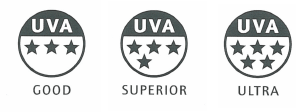We get it – sunscreen is really difficult to understand. But choosing the right product is one of the best ways to increase your protection against the sun’s harmful UV rays and reduce your risk of skin cancer.
What’s the difference between UVA and UVB rays? Why do some brands have a star rating but others don’t? And isn’t SPF the only thing that matters anyway? Sometimes when you’re picking up your sunscreen, the whole experience can be so overwhelming that you’re at risk of picking a product that isn’t suitable for your needs. One of the easiest ways to keep your skin healthy and happy is to use products that are 100% suitable for it. So, be overwhelmed no longer, with grüum’s ultimate guide to understanding sunscreen.
How does sunscreen work?
How your sunscreen works depends on whether it is an inorganic or organic formula. Inorganic formulas reflect the light away from our skin, whereas organic formulas absorb the UV rays so that our skin doesn’t.
Products are constantly developing to ensure good protection across the UVA and UVB spectrum. The two latest developments in sunscreen include Tinosorb A2B which is a filter that addresses the gaps between UVA and UVB absorption and nanotechnology which allows sunscreens to sit comfortably on the surface of the skin rather than being absorbed into it. At the moment, no sunscreen completely blocks all UV rays out, but one at the right SPF used frequently in the right quantity will provide sufficient protection for most people.
UVA and UVB – what’s the difference?
Too much exposure to UV rays is the leading cause of skin cancer. This can come either through sun exposure or through using sunbeds (which is something we definitely do not recommend). There are two main types of UV rays that damage our skin; both types can also cause skin cancer.
- UVA rays penetrate the skin deeply, causing damage to collagen and elastin in the skin. UVA rays pose a risk all year round, as they easily filter through clouds. They even penetrate glass so we’re pretty much never safe from them. The main concern UVA presents is to the ageing of the skin, although it can contribute towards burning and skin cancers.
- UVB rays damage the superficial layer of the skin and is responsible for the majority of sunburn. Sunburn is our skin’s way of telling us its cell DNA has been damaged. We can prevent this by using a sunscreen with a higher SPF – the lower the SPF the quicker you will burn.
The easiest way to remember it is to think of ‘A for ageing’ and ‘B for burning’.
What SPF should I be using?
SPF – which is an abbreviation for ‘sun protection factor’ – is one of the most common criteria people use when buying sunscreen. It indicates the number of times longer you can stay in the sun before burning, compared against not wearing any sunscreen. The SPF of sunscreen ranges from 2 to 50+ and products with higher ratings offer more protection, but only from UVB rays. SPF doesn’t take into account how protected you are from UVA rays (more on that later). Melanoma UK recommends a sunscreen with an SPF of at least 30 to ensure that you are sufficiently protected. However, in situations where the risk from UVB rays is higher (so on very hot and sunny days), it’s definitely a good idea to up your SPF.
The SPF you should be using personally does depend on your natural skin colouration. People who are very fair skinned, have red hair, or have lots of freckles are at more risk from damage caused by UVB rays, so should use a sunscreen with a higher SPF. People with naturally dark brown or black skin burn less easily, so could use a lower SPF sunscreen, though we would still not recommend less than SPF30 at an absolute minimum. Our sunscreen is available in SPF30 and SPF50, offering a good level of protection for a variety of skin colourings.

…and what about those star ratings?
Star ratings are, in essence, like an SPF for UVA rays. In the UK, products are available with a star rating of three to five stars, which indicates the ratio of UVA to UVB offered by sunscreens, meaning that the UVA rating is proportional to the SPF rating; so if an SPF30 and SPF50 product had the same star rating, the SPF50 product would offer more protection. Cancer Research UK recommends using a sunscreen with a UVA star rating of at least four stars; Both our sunscreen products offers five star protection.
However, the star rating system is not used worldwide in the same way as SPF. If you’re abroad and in need of more sunscreen, or buying a brand that isn’t UK based, the UVA protection offered by a sunscreen is indicated differently. We’ve put together a quick overview of the most commonly seen ones. In the EU a ‘UVA seal’ indicates that a product has ⅓ of the UVA protection as it does UVB protection; this is shown as a circle containing the letters UVA. A PPD rating compares the result between how long it takes skin that is exposed to artificial UVA rays to tan when using a product or not using any product, so a PPD of 10 means it takes ten times as long to tan when using the sunscreen compared against bare skin. The PA system works similarly to the star rating system, attributing a rating of between PA+ up to PA++++, however as it is comparative to SPF a product with different SPF could show the same PA rating but offer a different level of protection.

Is there anything else I should be on the lookout for?
Protection from UVA and UVB rays are the most important, there are still a number of other confusing factors that make sunscreen purchasing that little bit more hellish.
One of the things to think about is your preferred application method. We think the original cream type is the best, as it’s the easiest to gauge how much you’re using – and not using enough is one of the biggest mistakes that can be made!
More expensive brands will not necessarily offer more protection, in terms of that it’s more important to look for products with higher SPF and UVA star ratings. Where you may prefer brand-loyalty is in the other skin care benefits. For example, very water-resistant products can be quite oily and may be one to avoid if you’re prone to breakouts. It’s worth keeping an eye out for ‘non-comedogenic’ products, as they will be much less likely to cause breakouts. Whilst we’re on water-resistant products, they’re good if you’re spending a lot of the time in water (so a day at water park, or activities like surfing), but not wholly necessary otherwise. They also don’t exempt you from any re-application, as towel-drying can actually cause the sunscreen to come off more quickly. We would also recommend that you steer clear of ‘one a day’ products as activities such as swimming can cause them to come off, and they do not allow for the likelihood of sunscreen not being applied properly – reapplying regularly helps to make up for human error here.
Will sunscreen completely protect me?
No – nothing will completely protect you from the sun other than staying indoors and away from any form of sunlight, which doesn’t sound like much fun. However, when using a high SPF and UVA protecting product that is applied correctly, both in terms of regularity and quantity, most people are very unlikely to get sunburnt. It’s also important to not be tempted to spend more time in the sun, just because you’re wearing a sunscreen.



